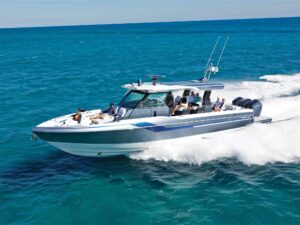The Yamaha F225 four-stroke was a treat to drive on every application we tested — there were twin engine offshore boats, bayboats, walleye boats and more. But our guys were captivated by the sleek Hurricane Sundeck 237 with 225 horses lunging at the mooring lines. Wait. This boat had a stern drive last time we took it for a spin, a 5.7L bruiser if memory serves. So, is a 225 going to give it the performance a family-hauling, tube-pulling fun cruiser would get from a big V-8 inboard?
After driving it, we thought so. Plus, all that space dedicated to the inboard engine is now dedicated to inboard fun. How would you like to add 12 square feet of party space to your deck? We thought so, too.
And quiet? We heard wind and rushing water, little else. At idle, a peek at the tach was required to see if the engine was running. At the dock, we confess, somebody tried to restart an already running engine — three times. A motor this quiet can’t be running. It needs a warning signal for re-start dummies — ”Hey idiot! I’m already running!”
Now, don’t read any more if you don’t care to know why it’s so fast, quiet and efficient. But for those of you who do …
The beauty of the F225 comes from its elegant design. Yamaha engineers didn’t exactly break the rules in an exercise of civil disobedience. They occupied new territory.
To trim down its size they made it a 60-degree V-6 block. But the big deal in both size and power was the clever way they fed air and fuel to this double-overhead cam engine. On auto engines, the air intake is on the center of the V, taking up a huge (huge by outboard standards) amount of space.Yamaha put the air intakes on the outside, sweeping the air supply through intake silencers forward on the engine to the intake valves on the back.
They had another trick up their sleeve. Each intake tube gets it own fuel injector located just before the intake valve. The result? Extremely efficient air and fuel mixture for a clean, powerful burn — and even more compact design.
To crown this unique achievement,the exhaust was taken from the center of the cylinder banks, in the V — exactly the opposite of your automobile’s four-stroke engine — and swept efficiently down and out through the propeller.
So, what did we find in our test drive that stats can’t tell you? First, all those who said they’d never make a big block four-stroke outboard that a boat could carry were wrong. This boat sat level and true in the water. The hole-shot of tested boats showed no sign of a tail-heavy boat. Indeed all rigs were balanced. Know why? The F225 weighs nearly 300 pounds less than the nearest likely stern-drive alternative — a 4.3L 210hp unit — and a scant 100 pounds more than competitive two-stroke DFI 225hp outboards.
We also noticed the power in this engine was equally applied across the operating range. There were no dead spots, no wasted rpm. For each 500-rpm increase, there was a commensurate increase in torque and speed.
Awesome, but how much? It sounds like the MSRP will be a cool $17,440.
Yamaha Motor Corporation; 800-88-Yamaha; www.yamaha-motor.com
SPECIFICATIONS:
YAMAHA F225 4-STROKE
- Block: 60 degree V-6
- Displacement: 3.35 L
- Full Throttle RPM Range: 5,000-6,000
- Horsepower Rating at Propshaft: 225 hp @ 5,500 RPM
- Weight 25” Shaft: 583 lb.
- Weight 30” Shaft: 596 lb.
- MSRP: $17,440
HURRICANE SUNDECK 237W/YAMAHA F225 OUTBOARD
This great-looking rig seemed to have all the thrust we’d expect from a big block stern-drive. You get a clean,green, fuel-efficient engine, more cockpit space for your boatingbuck.
- Length: 23’2”
- Beam: 8’5”
- Weight w/o Engine: 3,010 lb.
- Weight of Yamaha F225: 583 lb.
- Top Speed: 46.2 MPH
- Acceleration to 30 MPH: 7.5 sec.
- Time to Plane: 2.9 sec.
- Minumum Planing Speed: 20.0 MPH
- Noise @ Idle: 54 db
- Noise @ 30 MPH: 77 db
- GPH @ Cruise: 4.8 @ 3,000 RPM
- Propeller: 15 ¼” x 19” stainless
SKEETER ZX 2200 W/YAMAHA F225OUTBOARD
The big question skinny-water anglers have is, ”How will this work on my bay boat?” Very well, thank you. The rig was balanced,graceful and quick. With this open cockpit, center console,decibels appear high at 30 mph, but your ear will tell you tell the sound is environmental, not engine noise. We wouldn’t be afraid to mount this on any center console or bay boat over 20feet.
- Length: 21’10”
- Beam: 8’2”
- Weight w/o Engine: 2,400 lb.
- Weight of Yamaha F225: 583 lb.
- Top Speed: 52.6 MPH
- Acceleration to 30 MPH: 7.5 sec.
- Time to Plane: 2.9 sec.
- Minumum Planing Speed: 18.6 MPH
- Noise @ Idle: 58 db
- Noise @ 30 MPH: 84 db
- GPH @ Cruise: 8 gal. @ 4,000 RPM
- Propeller: 14 ½” x 21” stainless
GRADY WHITE 263 CHASE W/TWINYAMAHA F225 OUTBOARDS
The Grady White 263 with twins was a pure pleasure. Not only do you run with the joy of two well-synchronized outboards behind you, you run with peace. Very quiet. Even at 30 mph, wind, rushing water and conversation were more pronounced than engine sound.
- Length: 26’11”
- Beam: 8’6”
- Weight w/o Engines: 3,975 lb.
- Weight of 2 Yamaha F225s: 1,166 lb.
- Top Speed: 52.0 MPH
- Acceleration to 30 MPH: 5.4 sec.
- Time to Plane: 2.9 sec.
- Minumum Planing Speed: 20 mph
- Sound @ Idle: 51 db
- Sound @ 30 MPH: 82 db
- GPH @ Cruise: 9.1 gph @ 3,000 RPM
- Propeller: 15 ¼ ” x 19” stainless








